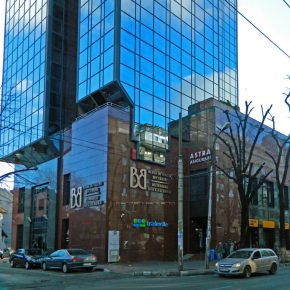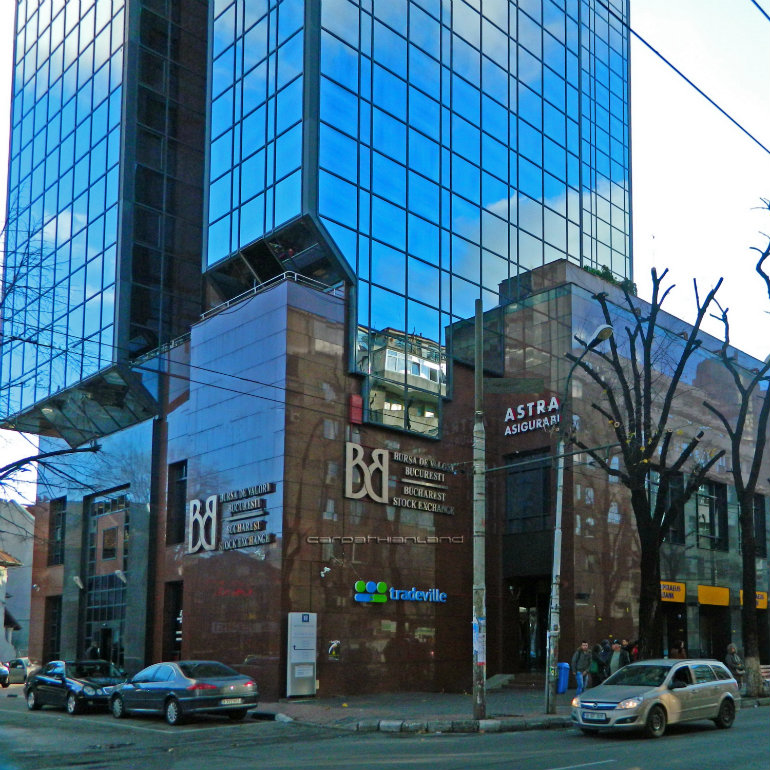
Bucharest Stock Exchange, Romania (Classic Bucharest, CC BY-NC)
It has been more than two and half years since Ludwik Sobolewski, the former CEO of the Warsaw Stock Exchange, took the helm of the Romanian bourse in August 2013. Pushed by the enthusiasm of the authorities to make Bucharest a financial hub for South-eastern Europe, the European Bank for Reconstruction and Development (EBRD) acquired 4.99 per cent of the BVB shares in November 2014 and the bourse accelerated the legal and regulatory reforms. The EBRD then financed the regional trading platform ‘SEE Link’, launched in March 2016. The Link connects the Macedonian, Bulgarian and Croatian markets, while the Belgrade and Ljubljana bourses (the latter is owned by Zagreb since July 2015) are expected to join the Link shortly. The BVB with the support of the EBRD aims to be a part of this regional dynamics.
At the same time, the year 2015 was disappointing for the BVB. While the market capitalization reached RON146bn (EUR32bn) with 84 listed companies in the main market, the average daily turnover dropped from RON52m (EUR11.7m) to RON35m (EUR7.9m). The downward trend seems to continue with RON26.6m (EUR5.9m) after 75 trading sessions were concluded this year. As a result, the revenue of the BVB declined by 35 per cent from 2014 and the BVB share price by 21 per cent at the end of 2015, Romania-Insider reported. The recently re-elected BVB leadership is tasked to turn the table around and increase the market liquidity.
Prolonged privatisation-related IPOs
Sobolewski remains moderately optimistic. Interviewed by CE Financial Observer in November 2015, Sobolewski stressed the importance of the privatization programs in accelerating the capital market development in Bucharest. With an exception of the 4 per cent share in Rongaz, no initial public offerings (IPOs) took place in 2015. Later this year, however, the salt monopoly Salrom is expected to be privatized, while the investment fund Fondul Proprietatea which holds a minority stake in Salrom is also pressing for the IPOs of other state-owned enterprises such as Hidroelectrica. The list of potential privatization includes ports and airports in Constanta and Bucharest, Reuters reported.
Although, Sobolewski himself experienced a setback when he ‘temporarily’ took the leadership of Posta Romana in June 2014. His 15 month tenure aimed at the privatization of the postal company was met by resistance and pessimism, and the project was frozen after Sobolewski left the board. Surely, he hoped for the IPO-based privatization which increases the market capitalization as well as the daily turnover. They are two important indicators in upgrading of the BVB to an ‘emerging market’ according to the index providers such as American MSCI and European FTSE Russell. While Salrom is expected to be privatized, the exact method and schedule is yet to be announced or even decided. Other methods, the sale of those state-owned enterprises to foreign investors for example, do not necessarily exclude IPOs. On the contrary, experienced foreign investors would prefer to go public – the question is if it will be in Bucharest or in other cities.
Diversification of the Romanian market
In the aforementioned November interview by the Observer, Sobolewski also pointed out that the price/earnings ratio in Bucharest is the lowest in Central and Eastern Europe despite the general under-valuation. The market can ‘correct’ the valuation by trading more, and the diversification of products becomes a key to attract more investors. According to the Federation of European Securities Exchanges, the top 5 most traded shares (Banca Transilvania, Fondul Proprietatea, BRD – Groupe Société Générale, Romgaz and Electrica) were accounted for 76.4 per cent of total turnover during March 2016. The same measurement illustrates higher concentration of trades in Budapest (99.2 per cent) and Prague (94.9 per cent) while Warsaw and Sofia (Bulgarian Stock Exchange) are diversified with 44.2 per cent and 30.3 per cent respectively. The IPO-based privatization of Salrom and Hidroelectrica, for example, will have a positive impact in terms of both the diversification of trade and the valuation.
Another possibility of diversification is the alternative market for the early-stage companies and SMEs. The BVB’s renewed alternative market AeRO resembles NewConnect in Warsaw, perhaps due to Sobolewski’s personal experiences. The closure of RASDAQ, a reminder of the 1999 mass privatisation in 2014, expanded the listing and trading activities in AeRO, practically merging and re-structuring the two markets. After 75 trading sessions were concluded this year, the number of listed companies in AeRO is 304, with the average daily turnover of just under RON1m (EUR220,000) and the market capitalization of ROM2.9bn (EUR0.6bn). Likewise, the corporate bond market shows a sign of growth in the recent years in spite of the turnover fluctuations.
Regional competition and integration
One weakness of the BVB in terms of diversification is the lack of vivid derivatives and (energy) commodity markets, but it is both a setback and future opportunity for the BVB. Looking beyond Bucharest, Sibex – Sibiu Stock Exchange is engaged in both markets, clearing in Athens. Despite the bitter memory of the BVB’s failed acquisition of Sibex, the Sibex-Athens axis is complementary to the growth of the BVB as the Romanian capital market is yet to be developed to attract more regional investors. The engagement with the SEE Link would further enhance the access to liquid capital in the region.
The BVB today is comparable to Prague or Budapest in many indicators including the total market capitalization. With the sale of the Ljubljana Stock Exchange to Zagreb and the Budapest Stock Exchange to the Hungarian National Bank, the CEE Stock Exchange Group (CEESEG) binds only Vienna and Prague. The SEE Link thus can be viewed as an alternative, if not succeeding, regional integration initiative in the securities market. With the nationalist conservative parties in power, the Warsaw or Budapest Stock Exchange is less likely to be sold or linked to another bourse. Thus, the BVB can fully enjoy the synergy effect as a leading securities market in the region – with a cautious look on the political upheavals in neighboring Ukraine and Turkey.

